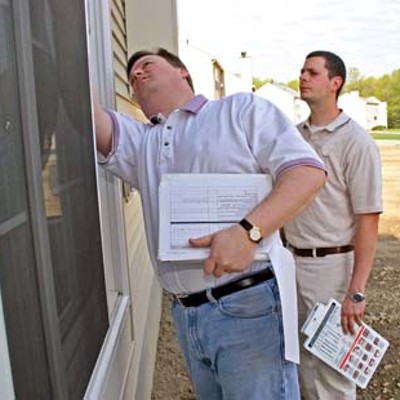Considering the available incentive programs, low interest rates and low home prices, the number of first-time homebuyers in the market has increased to approximately 47 percent, up by more than 10 percent since 2006, according to the National Association of Realtors. But even with these positive conditions, the process of buying a home for the first time hasn’t gotten any easier. This step-by-step guide will help you get an idea of the ride to come -- plus a few tips for making the journey go smoothly.
What can I afford? What will my payment be?
Your situation is unique to you. Experts recommend you first decide what monthly payment is comfortable for your situation then figure out what price home that will allow you to purchase. Factors in your decision will include how much you plan to put “down,” the interest rate you’ll qualify for and whether you’re looking at a 10-, 15- or 30-year mortgage. As a first time homebuyer don’t forget to factor in a monthly cost for property taxes and any condo or maintenance fee that may come with your property choice. There is a helpful array of calculators at www.realtor.com that allows a homebuyer to plug in different scenarios and easily see how a different purchase price, down payment or interest rate will change the monthly payment and overall investment throughout the life of the loan.
Arrange financing
If you want to buy a house, you need to know what you can afford – but even more important you need to know what the bank will agree to loan you. Down payments can range from 3.5 percent for an FHA loan to 20 percent or higher, if buyers are looking to avoid paying mortgage insurance. The remaining funds to purchase the house must come from a bank, credit union or other lender. A mortgage broker may also help compare lenders. Interest may be paid at either a fixed year rate – often over 30 years -- where the interest remains the same over the life of the loan. While there are adjustable rate loans (which start lower than the fixed rate but typically rise over the fixed rate within a few years) choosing an ARM (adjustable rate mortgage) can create problems for those who do not plan for higher rates or loss of income. Peter Richmond, author of The Complete Idiot’s Guide To Buying A Home (Alpha, 2010), has this advice for homebuyers: “I tell people to sit down and take a realistic look at your financial situation. Consider the worst case scenario: if you lost your job and the adjustable rate hit the ceiling, could you still afford the payment?” If you are unsure don’t risk it, take the fixed rate. “You should own the house, not the other way around.” Currently fixed mortgage rates are in the range of 4-5 percent, low enough that most buyers won’t even want to think about going any other way.
Finding an agent
Real estate agents work on commission and are responsible for researching available homes, finding comps (comparable home sales in the area) to help you figure out a fair price for the property and for presenting your offer to the seller, advising you through any negotiation that might be required. The listing agent and selling agent will each earn a fee that is paid by the seller; that fee shouldn’t have any impact on the final price of the home, it is the seller’s responsibility to pay it. Typically you are better off working with a realtor who represents you and is not the listing agent on the property you are buying. (So there is no potential conflict of interest.) “What you really want to do is interview the agent,” says Ron Phipps, president-elect of the National Association of Realtors. “Talk to the person and see if you relate to them.”
Finding the right home
While “location, location, location” is important, many people forget to look at the big picture. “Get an aerial view,” Phipps says. “Plug into Google search and see how close the home is to waterways, open spaces. If you find there is a landfill a couple miles away, that may be something you want to know. In some areas you have a freeway or a junkyard behind your home that may not be visible.”
Seek out sellers and neighbors who live in the area you’re considering. They may be able to answer questions about schools, property taxes, crime, parks and traffic. George R. Moskoff, a licensed contractor in Sebastopol, Calif., warns against the “shroud of joy” that accompanies buyers, preventing them from looking at the house critically. “The buyer is thinking ‘How can I fit my furniture in living room?’, ‘Where will the TV go?’ and ‘Where can we put our kitchen table?’ instead of ‘Why does it feel so drafty in here?’ or ‘How come there are brown stains on the ceiling over in that corner?’”
It is also wise to make a list of the features your family is looking for in a home and review your list frequently as you are looking at properties. Use your list to compare each property to the last and stay focused on your specific needs. Then if you choose to compromise on a feature you will be doing that with your eyes open.
When looking at townhomes and condos, Phipps suggests asking about condo fees and the history of special assessments for projects such as replacing the roof, where unit owners share the costs. If the roof appears to need repair, find out what reserves are in the repair fund. The seller should supply the HOA bylaws along with minutes from meetings and the association’s financial records for your review.
Inspection
Buyers should expect to pay for a professional inspection of the home. Experts suggest buyers hire the inspector of their choice (not the agent’s) and accompany the inspector during the inspection, asking questions and making a list of your own concerns along the way. “Because of liability concerns, the written inspection report is often bland and may leave out many important concerns,” Irwin says. “But, speaking informally with you on the inspection tour, the inspector may reveal a host of potential problems that never get into the written report.” If the inspector is not able to answer all of your questions about a particular feature (like a pool) bring in a specialist. Purchase contracts should provide the buyer with options to negotiate for the costs of any serious repairs recommended by the inspector. Ask your realtor or attorney to explain your rights and confirm that your contract provides options after inspection.
The offer
Once you’ve decided on a home and settled on the price you want to offer you will prepare a written offer and be asked to provide “earnest money,” which shows the buyer you are serious about purchasing the home. Your offer to purchase should stipulate all details involved with your desire to purchase: it should stipulate your plans to have a satisfactory inspection, proposed dates for closing and possession. It may include requiring the seller to make certain repairs on the property (even before the inspection) or asking for some other property (appliances, furnishings, sheds etc.) to be part of the deal. Most offers receive counter-offers from the seller, resulting in a back and forth negotiation until the deal is struck -- or lost. Ask your realtor or attorney to explain exactly what the situation is with your earnest money and whether or not it will be refunded to you if are unable to secure a loan or the deal falls apart for some other reason. Don’t hesitate to ask lots of questions and be certain you know what you are agreeing to before the offer is presented to the seller.
Some tips on negotiation
“Don’t fall in love with one property,” Irwin warns. “Be willing to lowball the seller and possibly lose the property, in the hopes of getting a bargain.”
Michael Schatzki, founder of Negotiation Dynamics in Far Hills, N.J., says, “First-time homebuyers tend to be younger and less experienced as negotiators. As a result, they often pay more than they should.”
Don’t be afraid to start low, given the oversupply of houses on the market, Schatzki says. If the house is priced at $150,000 and similar homes have recently sold for $130,000, in a normal market you would probably offer $123,500.
Don’t expect the seller to agree with your offer, Schatzki says. “What you are looking for is a counter-offer,” he explains. “If you don’t get a counter-offer, you can increase your offer if you want to. If you do get a counter-offer, then the game is on. Concede slowly, be patient and take your time.”
Closing the deal
Your final step will be to close the deal. A contract is a contract once negotiation has taken place, you’ve worked out the details and have come to an agreement on price, terms, dates etc. After each party has agreed to all the terms, you’re ready to head back to the bank with your purchase contract to arrange the final loan approval, complete the inspection and think about what color to paint the living room.





















